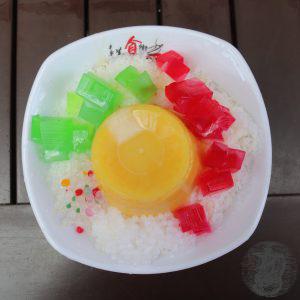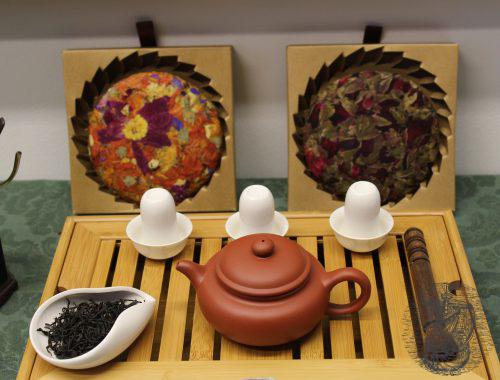
Tea Jelly – the asian candy
Do you know tea jelly?
Until recently I only knew salty jellies, also called aspic
These are jellies made from meat or fish. They are either served as an addition to other dishes, for example, red wine jelly with game, or other foods are put in aspic. For example egg and vegetables in aspic. Or fish in aspic.
In Asia, however, sweet jellies are very popular
There are different varieties with different tastes and colours. And it seems to me that the soft, rubbery consistency is very appealing to the Asians.
Bubble-tea was also invented in Asia, more precisely in Taiwan. The small, coloured spheres in, mostly cold, milk tea are made of tapioca or other starch. The syrup-filled spheres, on the other hand, are made from an algae extract.
In Singapore, we even found a market stall that only sells jellies. These are eaten as sweets, just like candy in our country.

And many desserts there are decorated with these colourful cubes. They can be found in all shapes, colours and tastes.

Among others, there is also the jasmine green tea or the Matcha variety
Which gave me the idea to make such tea jelly myself. Of course also because they are so difficult to get in our country.
I have tried making them with different kinds of tea. Green tea with jasmine, matcha, black tea, fruit tea and rooibos lemon. The imagination knows no bounds here either.
Everything that is liquid can be processed into jelly
Fruit juices or pureed fruit such as watermelon are also suitable.
My suggestion, however, is to prepare the tea stronger than you usually would. The jelly loses some of its flavour in the process. So I made them twice as strong as I would make a normal tea. So about 2 teaspoons of tea for 2.5 dl water.
You can also vary the sweetness according to taste. For 2 dl of tea, I used 50 g of sugar.
Of course, I had no idea how to make the tea gelify. As always in such cases, I first looked in my cupboard to see what I had that was suitable for gelifying.
I did find a few things: gelatine leaves, agar-agar, locust bean gum flour and jam gelatine.
One thing in advance, not everything worked for my purpose, but most of it.
Gelatine leave: works well, but contains animal products.
Agar-Agar: works very well and is vegan
Locust bean gum: only thickens, but does not gelify, unfortunately, does not work
Jam gelatine (pectin): goes, but doesn’t gel as strongly as gelatine or agar-agar, the jelly remains very soft and wobbly, is vegan
All in all, agar-agar was my favourite.
One more little tip. I sifted all the still liquid jellies to avoid gelling lumps.
Have fun trying it out!

Tea Jelly
Ingredients
- 2 dl liquid like tea
- 50 g of sugar white or whole cane can vary in quantity or be left out altogether, depending on taste
Gelling agent
- 4 sheets gelatine
or
- 15 g gelling agent for jam
or
- 15 g agar-agar The quantity can vary from brand to brand
Instructions
- Either soak the gelatine leaves in cold water and then mix into the hot liquid while stirring vigorously with a whisk
OR
- Stir the gelling agent for jam or the agar-agar into the cold liquid and bring to the boil while stirring with a whisk
- Then pour into suitable containers and allow to cool, then allow to set in the refrigerator for about 2 hours.




